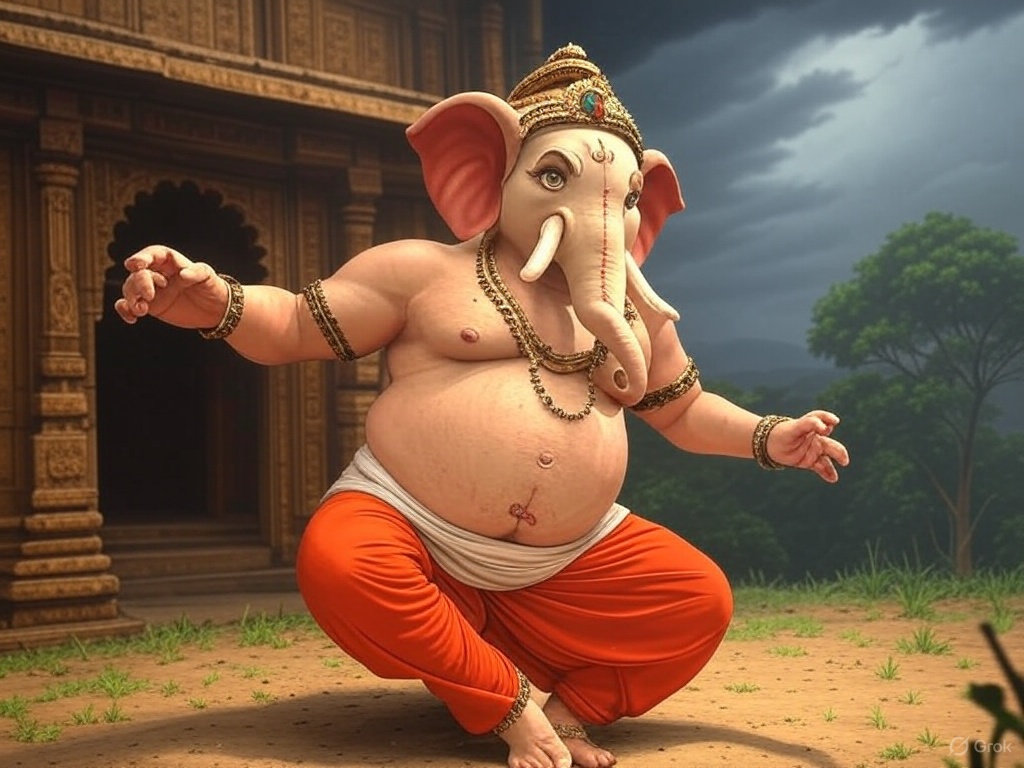The Rigveda knows him not. The term gaṇapati rings out twice, but it crowns Brahmanaspati or Indra.
This famous shloka for instance, is NOT in praise of the elephant-headed Ganesha:
gaṇānāṃ tvā gaṇapatiṃ havāmahe kaviṃ kavīnām upamaśravastamam |
jyeṣṭharājaṃ brahmaṇāṃ brahmaṇaspata ā naḥ śṛṇvan ūtibhiḥ sīda sādanam || Rigveda 2.23.1
“We invoke you, the lord of hosts (gaṇapati), the poet of poets, the most renowned; O Brahmanaspati, greatest king of sacred formulas, hearing us, come with your aids and settle in our seat.”
Sāyaṇa and medieval commentators (e.g., Veṅkaṭamādhava, 11th century) identify gaṇapati as Brahmanaspati (Bṛhaspati), the divine priest guiding Vedic rites, not Gaṇeśa. Krishan agrees, noting no elephantine or Gaṇeśa-specific traits.
Here, gaṇas likely refer to divine hosts or Maruts (storm gods aiding Indra), not Śiva’s attendants.
Another example:
pra yad gaṇena gaṇapatir havir naḥ pibāti somam urucakrir āpaḥ | sa naḥ svastiṃ jaradaṣṭir astu viśvāyur yo viśvabhojanaḥ syām ||
“When the lord of hosts (gaṇapati), with his band, drinks our Soma offering, he, the mighty worker, the waters’ lord; may he, the long-lived, grant us well-being, that we, all-enduring and all-nourishing, may thrive.”
Sāyaṇa and others (e.g., Uvaṭa, 11th century) link gaṇapati to Indra, the Soma-drinking warrior leading the Maruts.
The gaṇa is Indra’s troop, reinforcing his command, not Gaṇeśa’s gaṇas.
The Vedic commentators of the medieval period do not find any reference to Ganesha in the hymns mentioned earlier. Instead, they interpret the term "ganapati" in a variety of ways: as the lord of the hosts of gods, as the lord of all creatures, specifically as Indra, as Rudra (the lord of beasts, particularly horses), as the horse (lord of hosts), or as the lord of the gathering of women. These commentaries clearly establish that the term "ganapati" in the Vedas was not associated with the elephant-headed, pot-bellied Ganesha, nor did the word "ganas" refer to the mischief-making attendants of Shiva. - Y Krishan
The Many Legends of Gaṇeśa’s Birth
The origins of Gaṇeśa are shrouded in numerous Paurāṇic narratives, each offering a different perspective on his creation.
The most widely accepted story comes from the Śiva Purāṇa and Skanda Purāṇa, where Gaṇeśa is said to have been created by Goddess Pārvatī. As the legend goes, Pārvatī, desiring an attendant of her own, fashioned a figure from the turmeric paste on her body and breathed life into him. When she went to bathe, she instructed him to guard the entrance. Śiva, unaware of Gaṇeśa’s identity, attempted to enter and was stopped. A fierce battle ensued, culminating in Śiva severing Gaṇeśa’s head. Upon realizing his mistake and witnessing Pārvatī’s grief, Śiva resurrected the boy by affixing an elephant’s head to his body.
Another variation from the Liṅga Purāṇa presents Gaṇeśa as a direct creation of Śiva, born for the purpose of protecting the gods from malevolent beings. The Varāha Purāṇa, on the other hand, tells a more unique tale—Gaṇeśa was born as a radiant, handsome youth but was later cursed by Śiva out of jealousy, transforming into his now-iconic elephant-headed form.
The Vāmana Purāṇa takes a different approach, describing Gaṇeśa as being born from the dirt and sweat of Pārvatī. In this version, his elephantine features are a direct result of divine alchemy, symbolizing the synthesis of human and cosmic elements. Nepalese traditions go a step further, portraying Gaṇeśa as svayambhū, or self-created, reinforcing his divine and eternal nature.
The Evolution of Gaṇeśa’s Worship
Gaṇeśa was not always the widely revered deity he is today. Early Vedic texts barely mention him, and he does not appear as a major figure in early Hinduism. However, his prominence surged during the Gupta period, coinciding with the rise of devotional (bhakti) movements. Over time, he became synonymous with Vighnaharta (remover of obstacles)
By the medieval period, Gaṇeśa had evolved into a pan-Indian deity, incorporated into various regional traditions. His iconography adapted to local beliefs—whether depicted dancing in Maharashtra, as Heramba (five-headed Gaṇeśa) in Nepal, or as a Tantric figure in Buddhist esoteric traditions.
Gaṇeśa’s appeal extends beyond Hinduism. In Buddhism, particularly in Tibetan and Japanese traditions, he is known as Vināyaka or Kangiten, associated with prosperity and the removal of spiritual impediments.
Ganesha is absent from the Vedas, Panini’s works, Kautilya’s Arthashastra, the Ramayana, the Mahabharata, and Pali Buddhist literature. He is also not invoked in the Grhya and Dharmasutras at the start of auspicious rites. - Y Krishan
Before Gaṇeśa became the universally adored Vighnaharta (Remover of Obstacles), early Hindu texts depicted him in a different light—as one of the Vināyakas, a group of malevolent spirits associated with obstacles and misfortune. The term "Vināyaka" appears in early Sanskrit literature, including the Manusmṛti and Yājñavalkya Smṛti, where Vināyakas are mentioned as disruptive, mischievous beings capable of causing ailments and hindrances if not properly appeased.
The term "Ganesha," as it is understood today, appears relatively late in literature. Its true predecessor seems to have been one of its current synonyms, "Vinayaka." In its plural form, "Vinayakas" originally denoted evil spirits. In the Mahabharata (Vangavasi edition: iii, 65, 23; xii, 284, 13; xiii, 150, 25), they are described as unfriendly, malignant beings, similar to bhutas, rakshasas, and pishachas. In the Manava Grhya Sutras, dating from the seventh to fifth century B.C., a group of four Vinayakas is specifically named. Individuals possessed by them are driven to frustration, and they serve as obstacles to princes seeking kingdoms, as well as to people engaged in trade, farming, marriage, or childbirth. - Y Krishan
Before we meet again
Gaṇeśa’s journey—from an obstacle-creator to an obstacle-remover, from a chaotic Vināyaka to a divine protector—is a testament to Hinduism’s evolving nature. His myths are contradictory, his roles are dualistic, and his presence is universal.
We value your feedback and inputs. Please share your thoughts and let us have a dialogue.
You can reply to this email or reach out to us at




